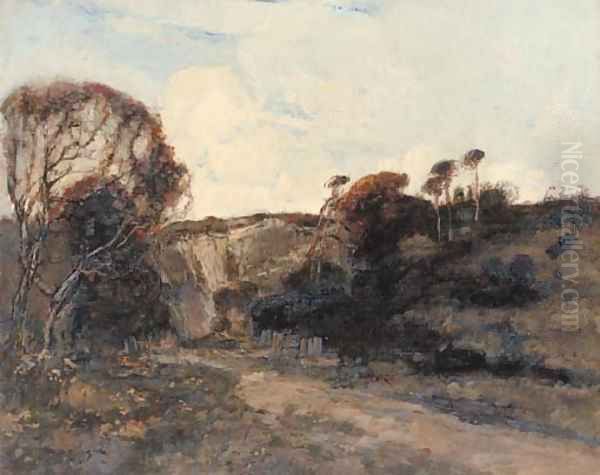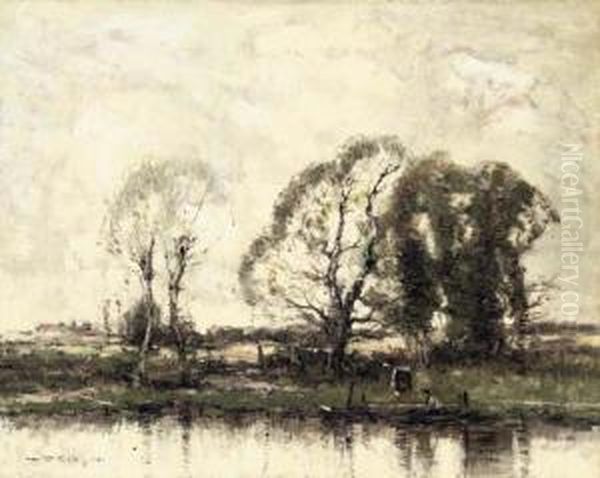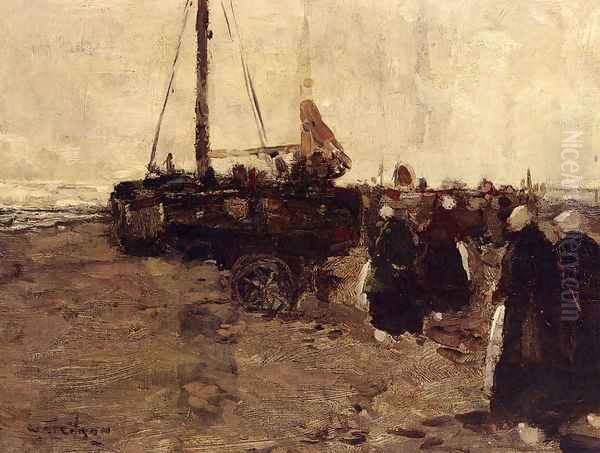William Alfred Gibson (1866-1931) remains a somewhat enigmatic figure in the annals of Scottish art history. While records confirm his existence and activity as an artist during a vibrant period of artistic development in Scotland, detailed biographical information is scarce and sometimes obscured by confusion with contemporaries bearing similar names. However, through the few works attributed to him and the context of the era, we can piece together an understanding of his place within the Scottish art scene, particularly his connection to the Impressionist tendencies that swept through Europe and found a unique expression north of the border.
The Artistic Climate in Scotland
The late nineteenth and early twentieth centuries were a period of significant artistic ferment in Scotland. Artists were increasingly looking beyond the constraints of traditional academic painting, inspired by developments on the Continent, particularly in France. The rise of Impressionism, with its emphasis on capturing fleeting moments, the effects of light and atmosphere, and painting en plein air (outdoors), resonated with many Scottish painters who were keen observers of their own dramatic landscapes and bustling urban scenes.
This era saw the flourishing of the Glasgow Boys, a loose collective of artists including figures like James Guthrie, John Lavery, George Henry, and E.A. Hornel. Active primarily from the 1880s onwards, they challenged the Edinburgh establishment, favouring realism, tonal harmony, and often depicting rural life and landscapes with a fresh, unidealized eye. Their work, influenced by French realists like Jules Bastien-Lepage as well as the Impressionists, paved the way for a distinctly Scottish modernism.
Following them, and overlapping in time, came the Scottish Colourists. This group, including S.J. Peploe, J.D. Fergusson, F.C.B. Cadell, and Leslie Hunter, took Scottish painting in an even bolder direction. Deeply influenced by French Post-Impressionism and Fauvism – the works of Henri Matisse, Paul Cézanne, and Vincent van Gogh were key inspirations – they employed vibrant, non-naturalistic colour and expressive brushwork. Their focus often fell on still lifes, elegant interiors, and sun-drenched landscapes, particularly those encountered during their travels in France.

Alongside these prominent groups, many other artists contributed to the richness of the period. William McTaggart, often considered the father of Scottish Impressionism, was an older contemporary whose dynamic seascapes and landscapes captured light and movement with remarkable vigour. Artists like Arthur Melville, known for his brilliant watercolour techniques and scenes from Spain and North Africa, also added an international dimension. It is within this dynamic and evolving artistic landscape that William Alfred Gibson worked.
Known Works: Capturing the Scottish Scene
Evidence points to William Alfred Gibson being active around the turn of the century and into the early 1900s. Two specific works are attributed to him, dating from approximately 1910: The Quarry and Quayside. These titles immediately suggest subjects deeply rooted in the Scottish environment – the interplay of industry and nature, and the life of its coastal towns and cities.
The Quarry, described as a Scottish Impressionist landscape, likely depicted a scene where human activity intersects with the natural world. Quarries, with their raw textures, dramatic forms, and changing light, offered compelling subject matter for artists interested in capturing atmospheric effects and the character of the land. An Impressionist approach would focus on the play of light on stone, the shadows within the excavation, and perhaps the figures of workers, rendered with attention to the overall visual impression rather than minute detail.
Quayside, identified as an Edwardian Glasgow Impressionist harbour scene, points towards Gibson's engagement with maritime subjects. The quaysides of Glasgow, a major industrial port city during the Edwardian era (1901-1910), would have teemed with activity: ships, cranes, cargo, dockworkers, and the distinctive atmosphere of the River Clyde. An Impressionist rendering would likely emphasize the reflections on the water, the smoke and steam mingling with the light, and the bustling energy of the scene, captured with relatively loose brushwork and a focus on tonal values. The "Glasgow Impressionist" label suggests an affinity with the styles prevalent in that city, perhaps closer to the tonal realism of the earlier Glasgow Boys than the high-keyed colour of the later Colourists.
Artistic Style and Approach
Based on the descriptions of his known works, William Alfred Gibson's style aligns with Scottish Impressionism. This suggests a focus on capturing the visual sensations of a scene, particularly the effects of light and atmosphere, using oil paints. The mention of "fine lines and tones" in the source material, while slightly ambiguous in an Impressionist context (which often prioritizes broken colour and looser forms over fine lines), might indicate a careful handling of composition and value contrasts within an overall Impressionist framework.

His choice of subject matter – landscape and maritime scenes – places him firmly within the mainstream of Scottish painting traditions. The Scottish landscape, in all its variety, and the nation's close relationship with the sea, were enduring themes. Gibson's contribution appears to be the application of Impressionist techniques to these familiar subjects during the Edwardian period. His work likely shared the Impressionist interest in contemporary life and scenery, rendered with a sensitivity to the specific light and weather conditions of Scotland.
Compared to the major figures of the time, Gibson's approach might be seen as part of the broader wave of Impressionist influence rather than groundbreaking innovation. He doesn't seem associated with the radical colour experiments of the Scottish Colourists like Peploe or Fergusson, nor perhaps the specific social realist edge found in some works by the Glasgow Boys like Guthrie. His style, as suggested by the descriptions, likely balanced observational accuracy with the atmospheric concerns central to Impressionism, perhaps akin to the work of French Impressionists like Claude Monet or Alfred Sisley in its focus on light and place, but translated into a Scottish context.
The Challenge of Biographical Clarity
It is crucial to acknowledge the difficulties in establishing a detailed biography for William Alfred Gibson, the artist (1866-1931). Research materials often present conflicting information, conflating him with other individuals named William Gibson or Alfred Gibson who were active in entirely different fields, such as agriculture, engineering, literature (the famous sci-fi author William Gibson), or even sports, and in different countries like Australia, Canada, or the USA.
Furthermore, information regarding artistic collaborators or competitors sometimes appears misattributed. For instance, mentions of collaborations with sculptors like HC Fehr or rivalries with figures like John Gibson (a prominent Neoclassical sculptor, 1790-1866) and Richard James Wyatt almost certainly refer to the earlier sculptor John Gibson, not the painter William Alfred Gibson. Similarly, claimed influences from movements like Surrealism or elements like Iroquois beadwork seem highly improbable for a Scottish Impressionist painter of his time and likely stem from confusion with other artists or writers.
Therefore, constructing his artistic life relies heavily on the few anchor points available: his lifespan, his identification as an artist, the specific titles and descriptions of The Quarry and Quayside, and their dating to circa 1910 within the context of Scottish Impressionism. Anecdotes, details of education, specific mentors, students, or definitive lists of exhibitions remain elusive for this particular artist based on the commonly available, often contradictory, records.
Legacy and Conclusion

William Alfred Gibson's legacy rests on his contribution, however sparsely documented, to the Scottish Impressionist movement during the Edwardian period. His works, The Quarry and Quayside, serve as tangible evidence of an artist engaged with the characteristic landscapes and maritime life of Scotland, interpreting them through the lens of Impressionism. He was part of a generation absorbing and adapting international artistic trends to a local context, contributing to the rich tapestry of Scottish art at a time of significant change.
While perhaps not possessing the high profile or extensive documented output of contemporaries like the leading Glasgow Boys or the Scottish Colourists, Gibson's work represents an important facet of the era's art scene. His paintings, focusing on light, tone, and atmosphere in Scottish settings, reflect the broader European shift towards Impressionism. He remains a figure deserving of clearer historical delineation, and his known works offer valuable glimpses into the Scotland of the early 20th century as seen through an Impressionist eye. Further research dedicated specifically to differentiating him from namesakes and uncovering more about his life and oeuvre would be necessary to fully appreciate his individual contribution alongside renowned figures like Lavery, Peploe, McTaggart, and others who shaped modern Scottish art.